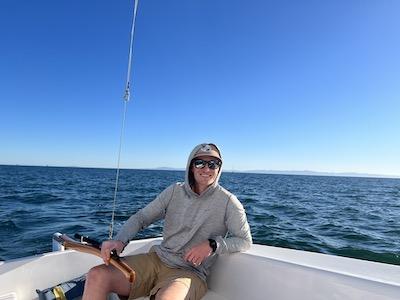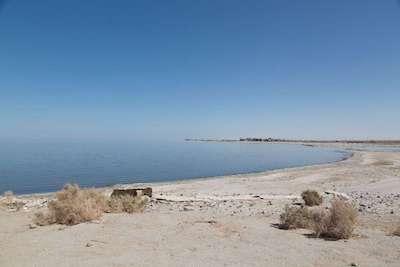Michael Wells never intended on a career in environmental or coastal issues. As an undergraduate, he studied economics, then worked in finance and the tech industries. But being an avid outdoorsman who enjoys surfing and camping as well as fly fishing and snowboarding, Wells couldn’t help but notice how climate change increasingly impacted his favorite places and hobbies.
“There were some pivotal moments — such as living downwind from the 2017 Tubbs Fire in Santa Rosa — but it was mostly a gradual process,” says Wells. “Eventually, it reached a tipping point where I knew addressing climate change was an all-hands-on-deck situation. Yet I was dedicating most of my time toward something much less important.”
Wells left his job and enrolled as a graduate student at the Bren School of Environmental Science and Management at the University of California, Santa Barbara, where he specialized in coastal marine resources management and economics and politics of the environment.
Using science to shape public policies
The idea of using science to shape public policies appeals to Wells. “Examining how social, environmental and economic issues are connected and how policy decisions affect each other requires strategy, creativity and an interdisciplinary thought process,” he says. The approach also “combines my prior economics and finance experience with my newly gained climate and coastal science knowledge.”

He applied for a 2022 California Sea Grant State Fellowship, a program that provides hands-on training by placing successful candidates with either a municipal, state or federal host agency in California, where they work at the intersection of science, policy, communication and management.
Wells spent his one-year fellowship at the California State Lands Commission, the agency responsible for managing and protecting the state’s natural and cultural resources. One of his focuses there was exploring the opportunities and challenges around the extraction of lithium from geothermal brines in Southern California. His research on the topic led him to co-author a scientific paper and appear at the State Lands Commission’s public meeting last October. “We were asked to present our findings and answer questions from Lieutenant Governor Eleni Kounalakis and our previous Controller, Betty Yee,” says Wells.
The central role of lithium
Lithium is central in California’s plan to achieve its clean air and climate change targets. The silvery-white metal is used in the lithium-ion batteries that power, among other key technologies, electric vehicles (EVs). Because of the surging interest in EVs and general battery storage, “the global demand for lithium is expected to increase over 600% between now and 2030,” says Wells.
Currently most of the world’s lithium is sourced from South America, China and Australia. Yet some of the largest known reserves are found in California, particularly around the Salton Sea, California’s biggest inland lake, located about a hundred miles east of San Diego. Experts believe that the Salton Sea area contains enough of the metal to produce up to 600,000 tons of lithium carbonate per year, which is more than the current global production.
The challenge: How to harvest it environmentally sustainably? Lithium is found in rocks and clay deposits as well as in brines, that is in water with high concentrations of minerals and salts found in certain underground aquifers. Extracting lithium in either form — by mining the rocks or pumping the brines into man-made surface pools where the water evaporates, leaving the lithium behind — uses large amounts of groundwater and land and creates toxic waste and pollution. The evaporation method requires “up to 500,000 gallons of groundwater to produce just one ton of lithium carbonate,” says Wells.
A gentler way
Around the Salton Sea, things are meant to go differently. The lithium here is contained in brines that typically sit at least a mile underground, making them boiling hot. Several companies are already

pumping this heated liquid to the surface to siphon off its geothermal energy before piping it back down. At least in theory then, harvesting the lithium would only require filtering out the metal before the brine gets reinjected into the earth. “It has the potential to be a low-impact and multi-benefit extraction method that would co-produce lithium for batteries and clean energy for the power grid,” says Wells.
A small number of companies are currently looking to develop this method, which has been demonstrated in the laboratory but not yet at commercial scale. There are real challenges. The hot brine, which is saturated with minerals such as manganese, zinc and arsenic, is highly corrosive and easily damages steel and concrete. Another difficulty will be to ensure that any economic growth that might spring from the new technology will be equitable.
Creating opportunities in an economically challenged region
The Salton Sea sits about 40 miles north of the Mexican border within the boundaries of an ancient lake bed. The current sea was created in 1905 when floodwaters from the Colorado River broke free of an irrigation canal. In recent years, however, the water levels in the basin have declined precariously, and the sea is often taxed by algae blooms and agricultural runoff. (The water in the lake is separate from the geothermal brines underground.)
The surrounding area suffers from low wages and some of the highest unemployment rates in the state. Almost a fifth of the residents of Salton Sea-adjacent Imperial County live in poverty. Because of industry, agriculture, and dust blown from the drying seabed, air pollution is high. “It would be tragic if an economic boom happens there, but the local communities don’t benefit and only experience negative impacts like pollution and strains on their local resources,” says Wells. “That’s unfortunately common in other extractive industries around the world.” Hoping to prevent this, the California government is working closely with the local communities and Tribes and planning to tax the extracted lithium to help restore the distressed area. It’s projected that the industry could create up to 9,000 new jobs in the region.
The California Sea Grant State Fellowship has taught Wells that this is the kind of work he’d like to pursue. “I realized that I love working in public service and am very excited to continue down this path,” he says. He was recently hired by his host agency, the California State Lands Commission, to be an Environmental Scientist. In this role, he’ll continue to focus on climate and coastal issues such as sea level rise, offshore oil and gas and clean energy.
"I'm proud and excited my career change has worked out and I'm now getting to work on the issues I'm passionate about — climate change and protecting California's natural resources. I'm very grateful for the Bren School and the Sea Grant Fellowship for helping me get here."
About California Sea Grant
NOAA’s California Sea Grant College Program funds marine research, education and outreach throughout California. Headquartered at Scripps Institution of Oceanography at the University of California San Diego, California Sea Grant is one of 34 Sea Grant programs in the National Oceanic and Atmospheric Administration (NOAA), U.S. Department of Commerce.